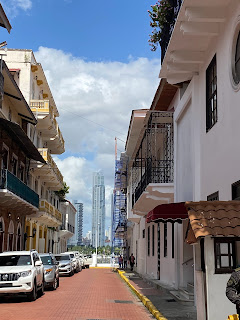Panama City, Panama -- Part 2. Yo, Ho, Natividad
The City, and the entire country, is one of the cleanest I have encountered in Latin America. Panama City is actually the only “First World” city south of the border. It has drinkable tap water throughout most of the country, and functioning water-treatment plants (something that Ouray is suffering for). Panama also provides public education, free health care, and I saw less homeless and litter than in L.A., or even Denver — all made possible by the capitalism of the Panama Canal. The Canal is an imperative supply chain between China, East/West US, and Europe. The Canal is so vitally important, the Chinese considered digging their own canal in a more authoritarian-friendly nation - but it proved too expensive. Which is substantive when you consider the passage fee is $1M per cargo ship.
1) All the Cathedrals have elaborate miniatures of the Nativity during the time of Advent. Housed in their basements, they detail it down to the last baby Jesus. It was like a miniature tiny town train set without the train. Also, the Minor Basilica has an interesting tale of English Pirates (of course, to the Spanish, Captain Drake and Captain Morgan were pirates (see Crossbones), they were seeking to find the Gold Alter rumored to exist. The Catholic indigenous converts covered the 20 ft. tall alter with clay, mud, and leaves to hide it from the Privateers — and were successful. It remains in restored splendor.
There is an old skeleton of a building with a “Flat Arch.” This is a flat brick bridge with an arched brick pattern. They built it to persuade America to finish the woe-begotten, and failed French Canal in the early nineteen-teens. The local Government built the flat brick arch to persuade Roosevelt to invest in Panama versus any other location central Americas because Panama has exceptional weather. Only subject to occasional flooding, and rarely (the tail-end) of hurricanes. The local government sent persuading letters to D.C. The stamps were designs of erupting volcanoes. Something Panama does not have, but neighboring countries have seismic issues. The Flat Arch stills stands over 100 years later.Flat Arch seen over gate
 |
| Cargo Ship |
We then toured the Locks and watched a cargo ship enter and exit via the Mulas (electric locomotives that act like guide mules). The balcony overlook was busy, but interesting. We could not view the museum part — due to it being an enclosed, tight area and lots of people passing through. (BTW, Panamanians are far better about wearing masks without complaint.)
Completed far before 1914, when the Canal was completed, Panama had a train route from the Pacific side to the Atlantic side — by the late 1800s. This train was actually the backbone of the California Gold rush and was the fastest (and safest) route to carry the gold back to the East coast, even after the US transcontinental railway was completed.
We ended the tour on a resort island, where we stopped for the best ceviche of the entire trip at Mi Ranchito Amador. There are several drivable islands near the Panama Lock system. The deposition of the land removed from the Locks connected these islands.
Of course, there was a duty-free shopping mall. Important: buy here and pack in your checked bag. If you intend to purchase duty-free booze, purchase it in one of the many locations around the city of Panama (there are many tourist/business duty free malls for this purpose) and pack it in your checked luggage. When flying out, we went through security, and then bought bottled water. They then required us to go through an ad hoc security with the same liquid rules AT OUR GATE! Thankfully, it was only a 12 oz, unopened H2O and not a yo-ho-ho bottle of rum from the duty-free shops behind security.











Comments
Post a Comment